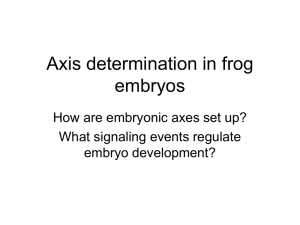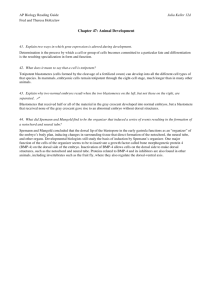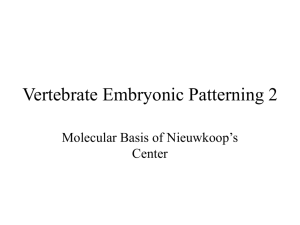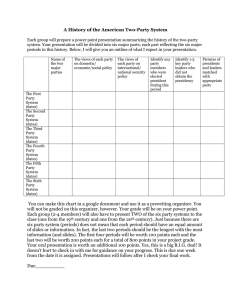Zoology 433 February 23 and 25, 2005 Outline
advertisement
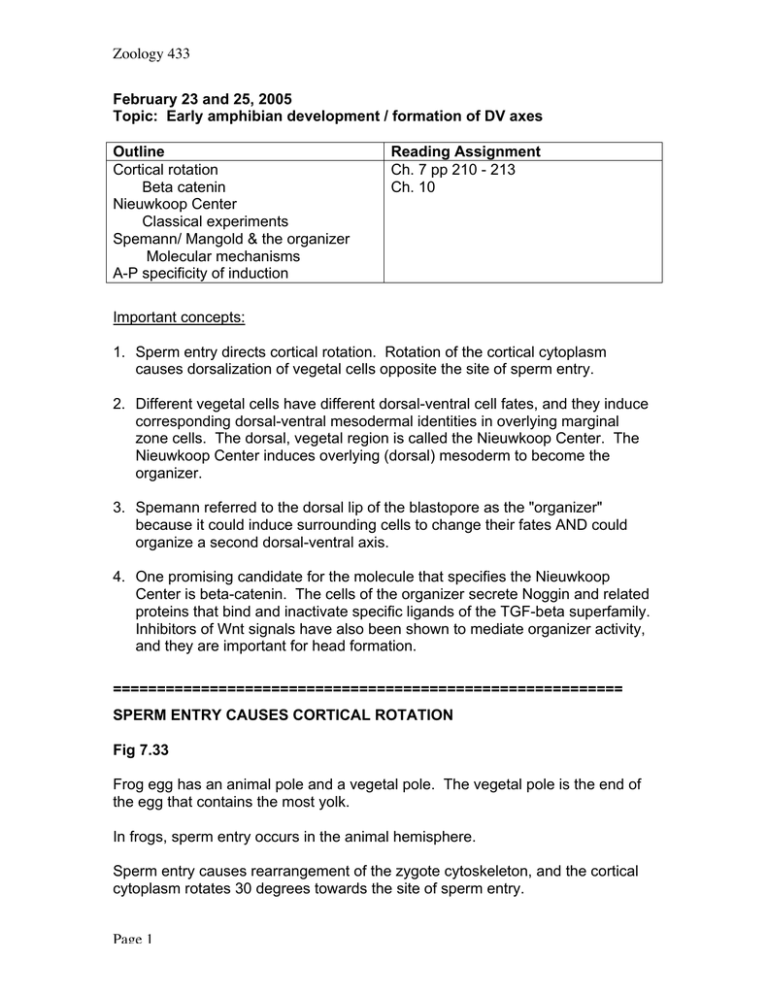
Zoology 433 February 23 and 25, 2005 Topic: Early amphibian development / formation of DV axes Outline Cortical rotation Beta catenin Nieuwkoop Center Classical experiments Spemann/ Mangold & the organizer Molecular mechanisms A-P specificity of induction Reading Assignment Ch. 7 pp 210 - 213 Ch. 10 Important concepts: 1. Sperm entry directs cortical rotation. Rotation of the cortical cytoplasm causes dorsalization of vegetal cells opposite the site of sperm entry. 2. Different vegetal cells have different dorsal-ventral cell fates, and they induce corresponding dorsal-ventral mesodermal identities in overlying marginal zone cells. The dorsal, vegetal region is called the Nieuwkoop Center. The Nieuwkoop Center induces overlying (dorsal) mesoderm to become the organizer. 3. Spemann referred to the dorsal lip of the blastopore as the "organizer" because it could induce surrounding cells to change their fates AND could organize a second dorsal-ventral axis. 4. One promising candidate for the molecule that specifies the Nieuwkoop Center is beta-catenin. The cells of the organizer secrete Noggin and related proteins that bind and inactivate specific ligands of the TGF-beta superfamily. Inhibitors of Wnt signals have also been shown to mediate organizer activity, and they are important for head formation. ========================================================== SPERM ENTRY CAUSES CORTICAL ROTATION Fig 7.33 Frog egg has an animal pole and a vegetal pole. The vegetal pole is the end of the egg that contains the most yolk. In frogs, sperm entry occurs in the animal hemisphere. Sperm entry causes rearrangement of the zygote cytoskeleton, and the cortical cytoplasm rotates 30 degrees towards the site of sperm entry. Page 1 Zoology 433 Cortical rotation specifies the dorsal-ventral axis. UV irradiation disrupts microtubules and cortical rotation. No cortical rotation ‡ no dorsal structures or tissues. Blastomere separation studies and the “gray crescent” Figure 10.19 Separate blastomeres at 2-cell stage. If one blastomere does not receive part of the “gray crescent”, then it forms “belly piece” with no dorsal tissues or structures. Question to class: what would a tadpole look like if it had two dorsal axes? Cortical rotation regulates nuclear localization of beta-catenin. Recall Wnt pathway (Fig 6.24) Beta-catenin has at least two cellular functions: binds to cadherin (Fig 3.28) and acts as a transcription factor (Fig 6.24). Go through Figure 10.25 Cortical rotation localizes Dsh opposite the site of sperm entry. Dsh ‡ beta-catenin. This is correlative evidence that beta-catenin is important for formation of the DV axis. Test the hypothesis that beta-catenin is necessary for formation of D-V axis Loss-of-function experiment: (antisense oligos deplete b-catenin mRNA) Test the hypothesis that beta-catenin is sufficient for specification of a new D-V axis: Gain-of-function experiment: Inject b-catenin into the ventral side of the embryo and form a secondary D-V axis Page 2 Zoology 433 DESCRIPTION OF EARLY AMPHIBIAN DEVELOPMENT Figures 10.1, 10.2 Draw first couple cleavages + blastocoel stage Cleavage Formation of blastocoel (apparent at ~128-cell stage) Blastocoel functions to (i) permit cell migration during gastrulation and (ii) keep presumptive endoderm and ectoderm from interacting prematurely. Fate map: animal cap fated to be ectoderm and veg pole fated to be endoderm Dorsal ectoderm fated to be neural tissue Dorsal mesoderm fated to be notochord Diagram fates of external cells (ectoderm & endoderm) Diagram fates of internal cells (marginal zone cells fated to be mesoderm) NIEUWKOOP CENTER Classical experiments. Cut off presumptive endoderm from a blastula. Cut off presumptive ectoderm. Make a sandwich (lacking any cells originally fated to be mesoderm). Some of the ectoderm will differentiate as mesoderm. (Fig 10.22 A &B) See Fig. 10.23 Different vegetal blastomeres induce different types of mesoderm. The cells in the vegetal region (prospective endoderm) have different D-V identities as a result of cortical rotation. The dorsal vegetal cells are called the Nieuwkoop Center. The Nieuwkoop Center induces overlying marginal zone cells to initiate gastrulation and to form dorsal mesoderm. Page 3 Zoology 433 See Fig 10.11 Dorsal vegetal blastomere of 64-cell embryo is sufficient to (i) rescue development of a UV-irradiated embryo (ii) induce a secondary D-V axis. End Wednesday / Start Friday DESCRIPTION OF GASTRULATION CELL MOVEMENTS Figure 10.7 & 10.13 • • • • • • Vegetal rotation Bottle cells invaginate --> blastopore forms Mesodermal precursors (mesodermal “deep cells”) involute Convergent extension drives expansion of archenteron Archenteron displaces blastocoel Animal cap epiboly Bottle cells are presumptive endoderm, and they invaginate and initiate formation of the archenteron. At least 2 hours before the bottle cells form, internal cell movements propel the cells of the dorsal floor the blastocoel towards the animal cap (figure 10.13B). This has been termed vegetal rotation. When the deep cells reach the blastopore lip, they initiate convergent extension. This drives elongation of the archenteron. During gastrulation, the animal cap cells expand via epiboly (see fig 8.5). Epiboly is the movement of one cell sheet over other, deeper cells. This can involve cell division, cell shape changes, and convergent extension. Interactions between cells above and below the blastocoel in the marginal zone result in induction of mesoderm. relationship between DV and AP axes. Frogs are deuterostomes (mouth forms second / blastopore forms anus) Figure 10.7 Page 4 Zoology 433 SPEMANN AND MANGOLD EXPERIMENTS Spemann asked : Are the cells of the early gastrula commited to specific cell fates? o Most cells are not (They are competent to respond to inducing signals from surrounding cells by adopting fates appropriate to the new location o “Dorsal blastopore lip” is (at this developmental stage, these cells are fated to become pharyngeal endoderm, dorsal mesoderm (notochord), and head mesenchyme) Generalized theme of development: Progressive restriction of cell fates As gastrulation proceeds, the ectoderm loses potency and becomes committed to specific fates. (Assayed by transplantation exps.) Fig 10.20: Discovery of organizer by Spemann & Mangold o when the organizer is transplanted to new positions in the early gastrula, it initiates gastrulation in it's new site. o additionally, the organizer induces surrounding tissues to adopt new fates, and it organizes a new axis. Spemann referred to the dorsal lip of the blastopore as the "organizer" because it could induce surrounding cells to change their fates AND could organize a second dorsal-ventral (and A/P) axis. Properties of “Spemann organizer” include: o Self-differentiates into dorsal mesoderm (e.g. notochord) o Induces surrounding tissue to form paraxial mesoderm (e.g. somites) o Induces dorsal fates in overlying ectoderm (e.g. neural tube) o Initiates gastrulation MOLECULAR SPECIFICATION OF DORSAL IDENTITIES Review N.C. (Figure 10.26) Finding the molecules responsible for organizer activity: Two major requirements of any candidate molecule 1. it must be present in the right time at the right place: the organizer 2. it must have the appropriate activity: any candidate molecule must dorsalize surrounding tissue. Several candidates have been identified, including transcription factors and secreted factors. Page 5 Zoology 433 The vegetal cells produce ligands of the TGF-beta superfamily that have a role in inducing ventral mesodermal cell fates. The organizer is thought to function in large part by inhibiting certain TGF-beta signals. Noggin and chordin bind directly to BMP ligands to inhibit their function. The cells of the organizer secrete molecules that bind and inactivate these TGFbeta ligands. The inhibitors secreted by the organizer dorsalize surrounding tissues. Dorsalized ectoderm adopts a neural cell fate. Many other transcription factors and signaling molecules have been identified as having important roles in organizer function. They are described in your text. REGIONAL SPECIFICITY OF INDUCTION FIG. 10.40 As endodermal and mesodermal cells are internalized during gastrulation, they appear to adopt appropriate anterior-posterior fates. As shown in Fig. 10.40, they can also induce the corresponding A-P identities in overlying ectoderm. Current models for this phenomenon incorporate at least two signals: 1. a signal from the organizer that confers neural cell fates 2. a signal from the posterior that is present in a gradient and confers posterior cell fates Scientists have searched for candidate molecules that might mediate these inductive events. Candidates for the neuralizing signal are similar to the array of molecules secreted by the organizer in the early gastrula: Noggin and other inhibitors of TGF-beta signaling. Candidates for the posteriorizing signal include retinoic acid, FGF, and Wnt. Page 6
